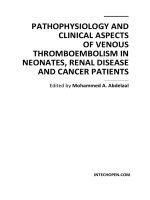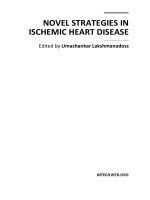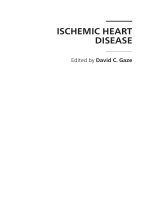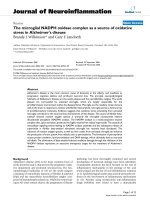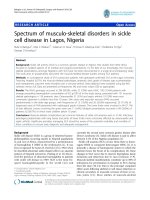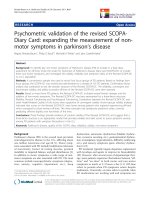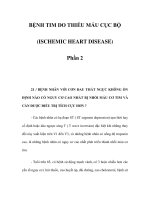Transplantation of skeletal myoblast in ischemic heart disease 1
Bạn đang xem bản rút gọn của tài liệu. Xem và tải ngay bản đầy đủ của tài liệu tại đây (136.07 KB, 15 trang )
TRANSPLANTATION OF SKELETAL MYOBLAST IN
ISCHEMIC HEART DISEASE
GUO CHANGFA
(M. Sc. & MD, Central South University, PR China)
A THESIS SUBMITTED
FOR THE DEGREE OF PHILOSOPHY
DEPARTMENT OF SURGERY
NATIONAL UNIVERSITY OF SINGAPORE
2007
i
Declaration
I declare that the research presented in this thesis, including research design, data
collection, and data analysis was conducted by the author, Guo Changfa. The results
of this work have not been submitted for degree at any other tertiary institute.
Copies (by any process) either in full, or of extracts, may be made in accordance with
instructions given by the author and lodged in the national University of Singapore.
Details may be obtained from the librarian of the National University of Singapore.
This page must form part of any such copies made. Further copies (by any process)
made in accordance with such instructions may not be made without the permission
(in writing) of the author.
Guo Changfa
July 2007
ii
Acknowledgements
In submitting this thesis, I would like to express my exceptional gratitude to my
supervisor groups. My sincerest thanks go to associate professor Eugene Sim for
giving me such an invaluable opportunity to engage in this project, for continuous
supervision, guidance and encouragement throughout this PhD study. Sincerest
thanks also to Dr Khawaja Husnain Haider, who has been a supervisor, elder brother
and friend to me. Your guidance, invaluable advice, support and understanding are
deeply appreciated. Sincere thanks to Dr. Winston Shim and Dr. Philip Wong, from
National Heart Center. Your invaluable support and guidance make this whole project
go smoothly.
Special gratitude goes to my wife, Zhang Huili. With your support, understanding and
contribution, I am completing the whole study in the long run.
Special thanks go to Dr. Tan Ru-San, National Heart Center, for kind technique
assistance in heart function analysis by echocardiography.
Special thanks go to associate professor Teh Ming, National University Hospital, for
providing technical guidance and opinion in tissue processing and histological
analysis.
My thanks also go to my lab mates, Dr. Jiang Shujia, Dr. Ye Lei, Dr. Zhang Wei, Dr.
Rufaihah Abdul Jalil, Ms Muhammad Idris Niagara, Ms Wahidah Bte Esa, Mr. Toh
Wee Chi, and Ms Su Liping for insightful discussions, technical and scientific advice,
and moral support.
Thanks also go to Professor Peter K Law, from Cell Transplants Singapore, for
providing the patented Supermedium and human skeletal myoblasts.
Special acknowledgement goes to members of Animal Holding Unit, NUS, for giving
me expertise advice and technical support with regards to animal work
And not to forget friends and family members who have been supportive and
encouraging throughout this enriching period of my life. I hope we will share the
delight of my accomplishment.
iii
Summary
Cell-based cardiac repair represents a promising therapeutic approach to treat heart
failure. Among various cell types, skeletal myoblast (SkM) has been extensively used
for cardiac cell therapy due to its myogenic potential, proliferative capacity,
resistance to ischemia, and non-tumorigenic nature. The present study was to
investigate the characteristics of human SkMs in vitro and in vivo, to investigate and
compare immune responses, SkM survival profile, and SkM transplantation efficacy
following xenogeneic, allogeneic, and autologous transplantation of SkMs in a rat
myocardial infarction model.
By immunostaining and cell counting, we showed that immunocytes infiltrated
severely in the early stage (from day-1 to day-7) after SkM transplantation.
Macrophages and CD8+ lymphocytes infiltrated from day-1; CD4+ lymphocytes
infiltrated from day-4, but all immunocytes subsided by day-28. By immunostaining,
real time PCR, and β-gal assay, we confirmed and quantified the survival of SkMs.
After transplantation, the majority of the SkM signals were rapidly lost by day-1.
After day-1, a gradual increase in the number of SkMs was observed until 4 weeks
after cell transplantation, resulting from the SkM proliferation out-balancing the
gradual loss. One interesting finding of our study is that the grafted human SkMs and
rat SkMs survive and differentiate well in the immunocompotent hosts even without
any immunosuppression. From this we suggest that SkMs enjoy a non-autologous
graft acceptance in myocardium, a finding which may have far reaching implications
in clinical perspective. In addition, we demonstrated that there was a close correlation
between immunocyte number and SkM total number.
In all SkM transplantation groups, SkM transplantation improved the heart
performance by increasing the contraction function (ejection function) and limiting
the ventricular dilation (left ventricular end diastolic diameter). Furthermore, we
demonstrated that there was a linear relationship between the SkM survival and
ventricular function as well. In our study, cyclosporine inhibited infiltration of the
immune cells, enhanced the survival of transplanted SkMs and improved heart
performance. Even in autologous groups, cyclosporine does enhance the heart
performance.
This study enabled us a better understanding of the early cellular behavior of SkMs,
especially human SkMs, and the underlying mechanisms that govern early graft
attrition in SkM transplantation. The present study also suggests a feasibility of non-
autologous SkM transplantation, especially allogeneic SkM transplantation.
iv
Abbreviation
ABCG2+ ATP-binding cassette transporter
Ad Adenovirus
AF Atrial fibrillation
AMI Acute myocardial infarction
BM Bone marrow
BMCs Bone marrow derived stem cells
BrdU 5-bromo-2’-deoxy-uridine
BSA Bovine serum albumin
CABG Coronary artery bypass grafting
CHF Congestive heart failure
c-kit Receptor for the stem cell factor.
CM Cardiomyocyte
CSCs Cardiac stem/progenitor cells
CX Circumflex coronary artery
DAB 3, 3-diaminobenzidine
DAPI 4, 6-diamidino-2-phenylindole
DMEM Dulbecco's Modified Eagle Medium
ECG Electrocardiogram
EF Ejection fraction
ELISA Enzyme linked immunosorbent assay
EPCs Endothelial progenitor cells
Fb Fibroblast
FBS Fetal bovine serum
FITC Fluorescein isothiocynate
FS Fractional shortening
G-CSF Granulocyte-colony stimulating factor
HRP Horse radish peroxidase
HSCs Hematopoietic stem cells
hSkM Human skeletal myoblast
IC Introcoronary infusion
ICS Intra coronary sinus
IHD Ischemic heart disease
Isl-1+ Insulin gene enhancer binding protein
KDR/Flk-1+ Vascular endothelial growth factor receptor
LAD Left anterior descending artery.
Lin Lineage markers
LVAD Left ventricular assist device
LVEDV Left ventricular end-diastolic volume
LVESV Left ventricular end-systolic volume
MDR1+ P-glycoprotein
MI Myocardial infarction
MMLV Moloney Murine Leukemia Virus
MSCs Mesenchymal stem cells
FISH Fluorescence in situ hybridization
v
HPF High power field
LVEDD Left ventricular end diastolic diameter
MHC Major histocompatibility complex
NYHA New York Heart Association
OD Optical density
PBS Phosphate buffered saline
PCI Percutaneous coronary intervention
PEI Percutaneous endoventricular injection
PET Positron emission tomography
rSkM Rat skeletal myoblast
Sca-1 Stem cell antigen 1
SkM Skeletal myoblast
SMA Smooth muscle actin
SP Cardiac side population
SSEA-1 Stem cell marker stage-specific embryonic antigen 1.
UPCs Uncommitted cardiac precursor cells.
VT Ventricular tachycardia
X-gal 5-bromo-4-chloro-3indoyl-β-D-galactosidase
vi
List of figures
Figure 1.1 Challenges to a successful cell therapy for cardiac repair 9
Figure 3.1 Representative images to show seeding and propagation of hSkMs 112
Figure 3.2 Doubling time of hSkMs by 4 times of independent counting 113
Figure 3.3 Representative images to show fusion of hSkMs into myotubes
in vitro 114
Figure 3.4 Desmin immunostaining and flow cytometry for hSkM purity 115
Figure 3.5 MHC I staining for hSkMs and myotubes 116
Figure 3.6 MHC II staining for hSkMs and myotubes 117
Figure 3.7 The labeling of SkMs by DAPI, BrdU, and lac-z gene 118
Figure 3.8 Creating and confirming rat model of MI 119
Figure 3.9 Representative images to show hSkM survival 120
Figure 3.10 Representative images to show hSkM survival by FISH 122
Figure 3.11 Human Y chromosome detection by PCR 123
Figure 3.12 Real time PCR to quantify the number of surviving SkMs 124
Figure 3.13 Quantification of the surviving hSkM number by β-gal assay 125
Figure 3.14 Myoblast differentiation after transplantation by immunostaining
for actin, myosin heavy chain fast and slow isoforms 126
Figure 3.15 Human cardiac troponin I and connexin 43 staining to show no
transdifferentiation of hSkMs into cardiomyocytes 127
Figure 3.16 Immunostaining and time observation of the infiltration of
macrophages 128
Figure 3.17 Immunostaining and time observation of the infiltration of
CD8+ lymphocytes 129
Figure 3.18 Immunostaining and time observation of the infiltration of
CD4+ lymphocytes 130
Fgure 3.19 MHC I down-regulation at 28 days after hSkM transplantation 131
Figure 3.20 MHC II down-regulation at 28 days after hSkM transplantation 133
Figure 3.21 The presence in the rat serum of antibody against hSkMs was
assessed by flow cytometric assays 135
Figure 3.22 The concentration of rat IgG by ELISA 137
Figure 3.23 The concentration of rat IgM by ELISA 138
Figure 3.24 Echo images to show the movement improvement on anterior
wall of left ventricle after hSkM transplantation into infarcted
myocardium 139
Figure 3.25 Effects of hSkM transplantation on cardiac function 141
Figure 3.26 Purity from different rSkM preplating by desmin immunostaining
and doubling time of rSkMs 142
Figure 3.27 Desmin immunostaining and flow cytometry assay for the
purity of rSkMs 143
Figure 3.28 Time observation of the infiltration of macrophages, CD8+,
and CD4+ cells 144
Figure 3.29 Time observation of the IgG and IgM concentration in
allogeneic and autologous transplantation groups 145
Figure 3.30 Myoblast survival after transplantation by real time PCR
vii
and β-gal assay 146
Figure 3.31 Linear relationship between the numbers of infiltrating macrophages,
CD8+, CD4+ cells and total cell numbers of SkMs 147
Figure 3.32 Effects of SkM transplantation on cardiac function 149
Figure 3.33 Linear relationship between the cell survival and
ventricular function (EF) 150
viii
List of tables
Table 1.1 Cardiac progenitor cells so far identified and their characteristics 13
Table 1.2 Advantages of using SkMs for cardiac repair 29
Table 1.3 Myoblast transplantation for cardiac repair in preclinical studies 31
Table 1.4 Experimental studies comparing transplantation efficacy of SkMs
with other cell types in cardiac repair 40
Table 1.5 Clinical trials of SkM transplantation for cardiac repair 46
Table 2.1 Antibodies used in present thesis 83
Table 3.1 The time courses of SkM survival by real time PCR and β-gal assay. 108
Table 3.2 Time observation of immunocyte infiltration 109
Table 3.3 Serum Concentrations of IgG and IgM antibody (µg/ml) 110
Table 3.4 Heart functions in experimental groups 111
ix
Publications
Abstracts and Meetings:
• Guo CF, Haider Kh H, Ye L, et al. Human myoblasts are immunoprivileged
and survived in xenogeneic host without immunosuppression. FEBS J. 2006,
273(S1): 128
• Guo CF, Haider Kh H, Ye L, et al. Comparison of cell survival after myoblast
transplantation into myocardium: xenogenic transplantation versus allogenic
transplantation. European Heart Journal. 2006, 26(s): 548
• CF Guo, Haider Kh, Ye l et al. Human myoblasts survived in xenogeneic host
without immunosuppression: Are they immunoprivileged? J Card Surg 2006:
21: 634
• Guo CF., HAIDER, Kh Husnain, et al. Immune cellular dynamics after human
myoblast transplantation into rat infarcted heart. 8th NUS-NUH ANNUAL
SCIENTIFIC MEETING 2004. Singapore.
• Guo CF., Haider Kh H., Jiang SJ., et al. Optimization of myoblast
transplantation based on immune cellular dynamics after human myoblast
transplantation into rat infarcted heart. 2nd ASIA PACIFIC CONGRESS OF
HEART FAILURE, Jan 9-12, 2005, Singapore (Oral presentation).
• Guo CF., Haider Kh H., Ye L., et al. Human skeletal myoblasts are
immunoprivilaged and survive following xenotransplantation in the rat
infarcted heart. 17th ANNUAL SCIENTIFIC MEETING (SCS). Mar. 26-27,
2005, Singapore (Short list for Young Investigator Award).
• Guo CF., Kh H Haider, L. Ye, et al. Xenotransplanted human skeletal
myoblast for the infarcted heart repair. ESH – EBMT - EUROCORD
Euroconference on STEM CELL RESEARCH. April 15-17, 2005, Cascais,
Portugal (Awarded with European Commission’s Marie Curie Actions
Scholarship).
• Guo CF., Haider Kh H., Ye L., et al. Cyclosporine treatment enhances cell
survival after human myoblast transplantation into rat infarcted heart.
ISMICS: Eighth ANNUAL SCIENTIFIC MEETING, June 1-4, 2005, New
York, USA.
• Guo CF., Haider Kh H., Ye L, et al. Human myoblasts are immunoprivileged
and enhanced by cyclosporine treatment with improvement of heart function
after xenogeneic transplantation for cardiac repair. Combined Scientific
Meeting 2005, Singapore.
• Guo CF, Haider Kh H, Ye L, et al. Human myoblasts survived in xenogeneic
host without immunosuppression: are they immunoprivileged? The 3rd
International Congress of the Cardiac Bioassist Association. 8-10 Nov, 2005
Fort Collins, Colorado, USA (Oral presentation).
• Guo CF, Haider Kh H, Ye L, et al. Human skeletal myoblasts survived in
xenogeneic host with improved heart performance without
x
immunosuppression. ISMICS: Winter Section.2-4, Dec. 2005, Shang Hai,
China
• Guo CF, Haider Kh H, Ye L, et al. Human skeletal myoblast survived in
xenogeneic host and further enhanced by cyclosporine treatment with
improvement of heart performance. 18th Annual Scientific Meeting (SCS)
25th & 26th March, 2006. (Short list for Young Investigator Award).
• Guo CF, Haider Kh H, Ye L, et al. Comparison of myoblast survival after
transplantation into myocardium: xenogenic transplanation versus allogenic
transplantation. International Society for Stem Cell Research 4th Annual
Meeting. June 29-July 1, 2006. Toronto, ON, Canada
Manuscripts:
• Ye L, Haider HKh, Guo C, Sim EK.Cell-based VEGF delivery prevents donor
cell apoptosis after transplantation. Ann Thorac Surg. 2007 Mar; 83(3):1233-4.
• Guo C, HKh. Haider, Winston S.N. Shim et al. Myoblast-based cardiac repair:
xenomyoblast versus allomyoblast transplantation. J Thorac Cardiovas Surg.
2007; 134: 1332-9.
• Guo C, Winston S.N. Shim, Husnain Kh Haider et al. Transplantation of
xenografted human skeletal myoblasts for cardiac repair (Under submission).
xi
TABLE OF CONTENTS
Preface i
Declaration ii
Acknowledgements iii
Summary iv
Abbreviations v
List of figures vii
List of tables ix
Publications x
Table of contents xii
Chapter One: Introduction
Section I: Ischemic heart disease
1.1.1 Introduction to ischemic heart disease (IHD) 1
1.1.2 Current status on IHD treatment 3
1.1.3 No-option patients: a target population for cell therapy 4
1.1.4 Patients with end-stage ischemic cardiomyopathy: another target
population for cell therapy 5
1.1.5 The challenges: regenerate contractile tissue and reverse
remodeling by cell transplantation 6
1.1.5.1 rationale for cell transplantation 6
1.1.5.2 The challenges for a successful cell-based cardiac repair 8
Section II: Stem cell sources and delivery
1.2.1 The choice of donor cells 10
1.2.1.1 Fetal or neonatal cardiomyocytes 10
1.2.1.2 Myocardial stem cells 11
1.2.1.3 Embryonic stem (ES) cells 16
1.2.1.4 Bone marrow derived stem cells 18
1.2.1.5 Skeletal myobalsts (SkMs) 21
1.2.2 Cell delivery methods 21
1.2.2.1 Stem cell mobilization 22
1.2.2.2 Direct intramyocardial injection 23
1.2.2.2.1 Transepicardial injection 23
1.2.2.2.2 Transendocardial injection 24
1.2.2.2.3 Trans-coronary-vein injection 25
1.2.2.3 Transvascular approaches 26
1.2.2.3.1 Intravenous infusion 26
1.2.2.3.2 Intracoronary artery infusion 27
Section III: Myoblast-based cardiac repair
1.3.1 The rationale to choose myoblast transplantation 28
1.3.2 Pre-clinical assessment of SkMs for cardiac repair 30
1.3.2.1 Retention, distribution, and survival of transplanted SkM 34
1.3.2.2 Fate of transplanted SkM: cardiomyocyte or skeletal myofiber 36
1.3.2.3 Efficacy of SkM transplantation for cardiac repair 38
1.3.3 Clinical trials of autologous SkMs -based cardiac repair 41
xii
1.3.3.1 SkM transplantation as a adjunct to CABG 41
1.3.3.2 SkM transplantation as a stand–alone procedure 43
1.3.4 From autologous to allogeneic SkM transplantation 44
1.3.5 Current problems about SkM transplantation 48
Section IV: Purposes of the study 50
Chapter Two: Materials and Methods
2.1 Skeletal Myoblast Isolation and Culture Methodology 52
2.1.1 Human skeletal myoblast cultivation 52
2.1.2 Rat skeletal myoblast isolation and cultivation 52
2.1.2.1 Preconditioning of skeletal muscle prior to biopsy 52
2.1.2.2 Muscle biopsy, myoblast isolation and cell culture 53
2.2 Myoblast Purity Test 54
2.2.1 Desmin immunostaining 54
2.2.2 Flow cytometry assay 55
2.3 Myoblast doubling time by cell counting 56
2.4 Human skeletal myoblast fusion in vitro 57
2.5 Myoblast labeling 58
2.5.1 Lac-z reporter gene labeling 58
2.5.1.1 Retroviral vector propagation and purification 58
2.5.1.2 Lac-z gene transduction into myoblasts 59
2.5.1.3 Lac-z labeling efficiency 59
2.5.2 BrdU labeling 60
2.5.2.1 BrdU incorporation into myoblasts 60
2.5.2.2 Immunostaining for BrdU 60
2.5.3 DAPI labeling 61
2.5.3.1 DAPI Incorporation into myoblasts 61
2.5.3.2 DAPI labeling efficiency 62
2.6 Myoblast availability test by trypan blue exclusion 62
2.7 Rat mocardial infarction model and cell transplantation 62
2.7.1 Mocardial infarction model creation 62
2.7.2 Confirmation of myocardial infarction model 63
2.7.2.1 Macroscopic observation 63
2.7.2.2 Microscopic observation 63
2.7.2.3 Electrocardiogram (ECG) 64
2.7.2.4 Echocardiography 64
2.7.3 Animal groups 65
2.7.4 Myoblast transplantation 66
2.8 Animal euthanasia 67
2.9 Serum preparation and antibody detection 68
2.9.1 Serum preparation 68
2.9.2 Antibody concentration assay 68
2.9.2.1 Flow cytometry assay to detect antibody 68
2.9.2.2 Enzyme linked immunosorbent assay (Elisa) for
antiobody detection 69
2.10 Myoblast survival assay 70
2.10.1 Identification of transplanted cells by X-gal staining,
xiii
BrdU staining, and DAPI fluorescence detection 70
2.10.2 Identification of Myoblasts Using Fluorescence in Situ
Hybridization (FISH) 71
2.10.3 Time course about myoblast survival 72
2.10.3.1 PCR and real time PCR 72
2.10.3.1.1 DNA preparation 72
2.10.3.1.2 PCR and real time PCR 73
2.10.3.2 Myoblast survival by β-gal assay 74
2.11 MHC detection and expression 75
2.11.1 Immunostaining for MHC 75
2.11.2 MHC expression by RT-PCR 75
2.11.2.1 RNA preparation 75
2.11.2.2 RT-PCR 76
2.12 Histological and immunohistological study 78
2.12.1 Staining for skeletal muscle actin, and myosin heavy
chain fast and slow isoforms 78
2.12.2 Immunostaining for connexin 43 and troponin I 80
2.12.3 Macrophages and CD4+, CD8+ t-lymphocytes immunostaining 81
2.13 Function assessment 82
2.14 Statistical analysis 82
Chapter III: Results
Section I Human skeletal myoblast transplantation in rat infarcted model
3.1.1 Human skeletal myoblast culture and fusion 84
3.1.2 Purity of human skeletal myoblasts 85
3.1.3 MHC expression on human skeletal myoblasts 85
3.1.4 Human skeletal myoblast preparation before transplantation 86
3.1.5 Mortality and confirmation of rat model of myocardial infarction 86
3.1.6 Myoblast survival within the rat infarcted myocardium 87
3.1.7 Time course of hSkM survival 88
3.1.7.1 Cell survival by PCR and real time PCR analysis 88
3.1.7.2 Cell survival by β-gal assay 89
3.1.8 Fate of human skeletal myoblasts after grafting 90
3.1.9 Immunocellular dynamics after human SkM transplantation 91
3.1.10 MHC expression after human SkM transplantation 93
3.1.11 Antibody detection by floycytometry 94
3.1.12 Elisa for rat IgG and IgM after human SkM transplantation 94
3.1.13 Heart functional assessment 96
Section II: Rat skeletal myoblast transplantation: allogeneic
and autologous transplantation
3.2.1 Rat skeletal myoblast isolation, culture, and doubling time 99
3.2.2 Immucellular dynamics of allogeneic and autologous myoblast
transplantation 100
3.2.3 Elisa for rat IgG and IgM after allogeneic and autologous SkM
transplantation 102
3.2.4 Cell survival after transplantation 104
3.2.4.1 Cell Survival by Y chromosome Real Time PCR 104
xiv
3.2.4.2 Cell survival by β-gal assay 105
3.2.5 Heart function assay by echocardiography 105
Chapter IV Discussion and conclusion
4.1 Myocardial infarction model of Wistar rats 151
4.2 The cell delivery time and dosage 151
4.3 The labeling of the transplanted myoblasts 153
4.4 The methods to quantify the donor myoblast survival 156
4.5 Skeletal myoblast dynamics 157
4.6 Fate of SkM grafts after transplantation 159
4.7 Immunocellular dynamics and myoblast survival after transplantation 160
4.8 Major histocompatibility complex (MHC) expression in vitro and in
vivo on human SkMs 163
4.9 Transplantation of non-autologous myoblasts into myocardium 164
4.10 Comparison of allogeneic and autologous myoblast transplantation 166
4.11 Heart Performance by SkM Transplantation 167
4.12 Cyclosporine therapy in non-autologous myoblast transplantations 169
4.13 Cyclosporine treatment in autologous myoblast transplantation 171
4.14 Mechanism of myoblast transplantation 172
4.15 Limitation of the present study 175
4.16 Future directions 178
4.17 Conclusion 179
Bibliography 182
xv

